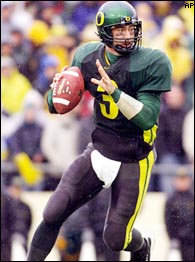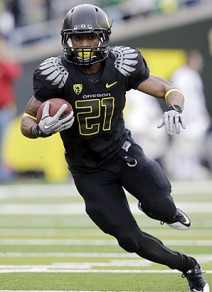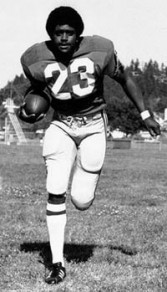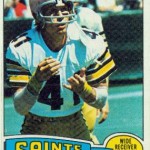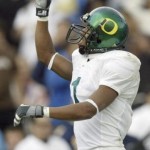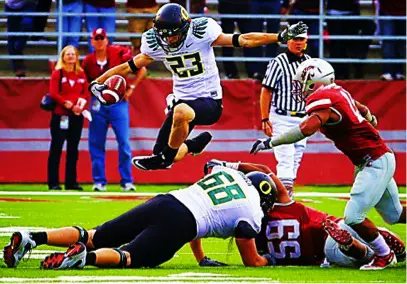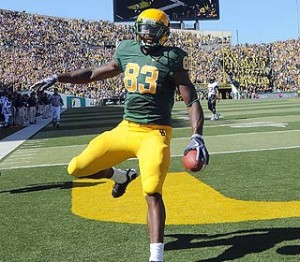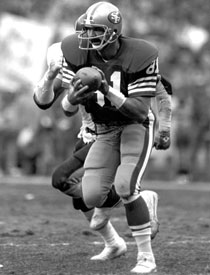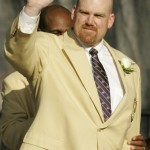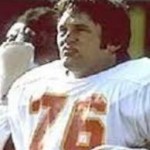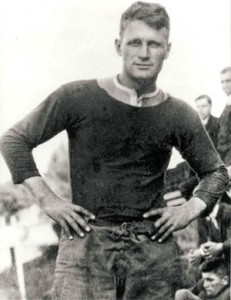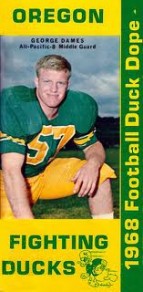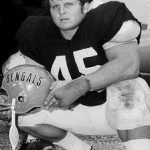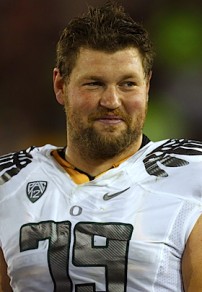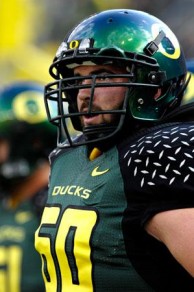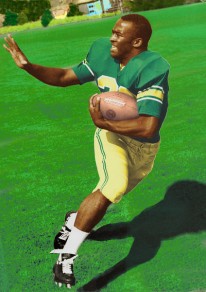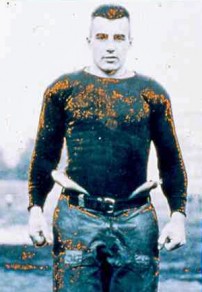
David Paulson
Many long-term Oregon football fans would probably love to see Joey Harrington hand the ball off to Bobby Moore, or Gary Zimmerman open up holes for LaMichael James to run through. Well, realistically no one could make that happen, but we can bring it to life on paper.
Looking back at the history of the Oregon football program, it is hard to compare the biggest Duck studs from different eras. Quarterbacks throw more than they used to, offensive linemen weigh more than in the past, and the team’s best skill players no longer play on both sides of the ball.
Though it is a challenge to look at the program’s historical players side-by-side, all of the hype surrounding fantasy football leagues and Madden’s ultimate team has inspired this attempt to create the ultimate team of Oregon football players.
Here is the roster, based on the talent, accomplishments, value, statistics, and NFL success of the players, for Oregon football’s all-time dream team offense.
Quarterback: Joey Harrington (1998-2001)
Joey Harrington may not have found quite the NFL success as other former Duck standouts such as Norm Van Brocklin and Dan Fouts, but he sure knew how to win football games.
Harrington was named the Ducks’ starter as a sophomore in 1999 after an elbow injury slowed A.J. Feeley, who despite never regaining the starter’s role also had a lengthy NFL career. Harrington led Oregon to a 44-41 comeback win against Arizona, earning him the nickname ‘Captain Comeback,’ that set the Ducks on a five-game winning streak to finish the year, including a come-from-behind Sun Bowl victory over Minnesota.
In 2000, Harrington threw for 2,694 yards and 20 touchdowns while leading the Ducks to an impressive 10-2 record, the school’s first 10-win season. The season culminated in a Holiday Bowl win over Texas, the highlight of the game being Harrington’s touchdown catch from wide receiver Keenan Howry on a trick play in the first quarter.
In 2001, ‘Captain Comeback’ was the team’s obvious MVP in what was arguably Oregon’s best season of all-time. Only a heartbreaking mid-season loss to Stanford kept the Ducks from an undefeated regular season and an appearance in the national championship game. Harrington, a Heisman finalist in 2001, ended his career on a high note with an impressive 38-16 victory over No. 3 Colorado in the Fiesta Bowl.
No matter what it took, Harrington always seemed to find a way to win. He finished with a career record of 27-3, and only lost one career game at Autzen Stadium. He remains one of Oregon’s top five all-time leaders in passing yardage. After being selected third overall in the 2002 NFL Draft by the Detroit Lions, Harrington played five seasons for three different teams. ‘Captain Comeback’ will forever be remembered in Eugene for his outstanding talent, leadership, and knack for winning.
Backup: Dan Fouts (1970-1972)
Fouts is one of only six Oregon players in the NFL Hall of Fame. Over the span of his career at Oregon, he threw for 5,995 yards on his way to breaking a total of 19 school records. In 1970, he led an amazing 21-point comeback over UCLA that ended in his game-winning touchdown pass to tight end Greg Specht. Fouts went on to have a very impressive 15-year career with the San Diego Chargers, during which he threw for more than 43,000 yards.
Backup: Norm Van Brocklin (1947-1948)
In only two years as Oregon’s starting quarterback, Norm Van Brocklin proved to be one of the school’s best of all-time. He was the Ducks’ first all-American quarterback, and totaled 1,949 yards and 18 touchdowns during his career. In 1948, he led the Ducks to a 9-2 records and a Cotton Bowl berth, one of the best seasons in school history. Like Fouts, he was eventually inducted into the NFL Hall of Fame, and to this day still holds the record for most passing yards in a single NFL game (554, 9/28/1951).
Honorable Mention Quarterback:
Bill Musgrave (1987-1990): A four-year starter, Musgrave is Oregon’s all-time leader in passing yards with 8,343. He played for the 49ers and Broncos, and remains a coach in the NFL.
Dennis Dixon (2004-2007): A lethal dual-threat quarterback, Dixon would have likely won the Heisman Trophy in 2007 had he not torn his ACL late in the season.
Bob Berry (1962-1964): Berry led the 1963 team to a Sun Bowl victory, the team’s first bowl win in 46 years, before playing for the Minnesota Vikings.
Reggie Ogburn (1979-1980): Another dynamic offensive weapon, Ogburn led the Ducks to two winning seasons in 1979 and 1980 after several years of team struggles.
Akili Smith (1996-1998): Smith threw for 5,148 career yards and was selected third overall by the Cincinnati Bengals in the 1999 NFL draft.
Running Back: LaMichael James (2009-2011)
The running back position is probably the hardest decision on this list, considering the steady stream of elite talent that has flowed in and out of Oregon’s backfield over the years. With that being said, it would be insane not to include the Ducks’ all-time leading rusher.
LaMichael James literally sprinted past Derrick Loville’s career record of 3,296 rushing yards in only three years. After taking over for a suspended LeGarrette Blount in 2009, James rushed for 1,546 yards and 14 touchdowns. In 2010, he was a Heisman Trophy finalist after racking up 1,731 yards and 24 total touchdowns. As a junior, James totaled 1,805 rushing yards and 18 touchdowns, despite missing a couple of games with injuries.
Throughout his career, James dazzled with his play-making ability, earning the Doak Walker Award his sophomore year, and breaking the all-time NCAA record for most runs of 30 yards or more. His amazing habit of emerging on the other side of seemingly impenetrable holes proved extremely valuable to the Ducks throughout his time in Eugene. Like Harrington, James’ three years of embarrassing defenders greatly contributed to immense success for the team, as the Ducks went 34-6 during his tenure.
James was selected in the second round of the 2012 NFL Draft by the San Francisco 49ers, and will compete for time in a crowded backfield in 2012. James’ 5,082 rushing yards and 5,869 all-purpose yards are both school records, and he will live as a legend in the hearts of Oregon fans for a very long time.
Running Back: Bobby Moore (Ahmad Rashad) (1969-1971)
Bobby Moore joined Dan Fouts and wide receiver Bob Newland in the early 1970s to complete a dangerous trio of offensive weapons. Now named Ahmad Rashad, Moore was one of the most elusive and athletic running backs in school history.
It is likely that Bobby Moore would be at or near the pinnacle of every Oregon rushing statistic had he not spent his sophomore year as a wide receiver, catching 54 passes. In 1970, he made the switch back to running back, and ended his career with 2,306 rushing yards and 22 rushing touchdowns.
On top of his rushing totals, Moore racked up an impressive 1,556 receiving yards, putting his career all-purpose yardage sum at 3,898 yards. His 36 career total touchdowns and five two-point conversions add up to 226 points, placing him third on the school’s all-time points scored list.
An all-American in 1971, Moore was the school’s first rusher to eclipse 1,000 yards in a season, and was the fourth overall selection in the 1972 NFL Draft by the St. Louis Cardinals. Moore would make up an unstoppable duo out of the backfield with LaMichael James.
Backup Running Back: Jonathan Stewart (2005-2007)
Coming out of high school, Jonathan Stewart was among the nation’s most highly-touted recruits, posting one of the highest SPARQ ratings in recent history. He possessed a blend of strength and speed that was almost unbelievable at times. Throughout his three years at Oregon, Stewart ran for 2,891 yards, including a 1,722-yard 2007 season that resulted in him being a semi-finalist for the Maxwell Award. He totaled 31 touchdowns over his career, and currently plays for the Carolina Panthers.
Backup Running Back: Derek Loville (1986-1989)
Until LaMichael James surpassed his numbers during the 2011 season, Derek Loville was Oregon’s all-time leading rusher with 3,296 career yards. Loville led the team in rushing during each of his four seasons, the first Duck to accomplish this feat. He went on to play eight seasons in the NFL with the Seattle Seahawks, San Francisco 49ers, and the Denver Broncos.
Honorable Mention Running Back:
Don Reynolds (1972-1974): Though he stood at only 5’8″, Reynolds racked up 2,210 yards throughout his career. An accomplished multi-sport athlete, he played major league baseball with the San Diego Padres.
Maurice Morris (2000-2001): In only two years at Oregon, Morris totaled 2,237 rushing yards.
Terrence Whitehead (2002-2005): Whitehead is high up on the list of nearly every statistical category at Oregon, totaling 2,832 rushing yards and 26 total touchdowns during his career.
Wide Receiver: Bob Newland (1968-1970)
Bob Newland was an absolute stud on an Oregon team loaded with offensive talent. In 1970, he joined running back Bobby Moore (now Ahmad Rashad) and quarterback Dan Fouts to form one of Oregon’s all-time most lethal offenses.
Between Newland, Fouts, and quarterback Tom Blanchard, the Ducks had the No. 2 passing attack in the country in 1970. That year, Newland set the school record for single-season receiving yards with 1,123, which has yet to be broken.
Newland was voted Oregon’s most valuable player in 1970 despite the outstanding play of Bobby Moore and Dan Fouts. He also led the Pac-8 in receiving, finishing ninth nationally in receiving yards.
The New Orleans Saints drafted Newland in 1971, where he started for four seasons. On top of his solid contributions during the 1968 and 1969 seasons, Newland’s 1970 campaign remains the best single-season performance ever by a Ducks receiver.
Wide Receiver: Samie Parker (2000-2003)
A great compliment to Newland, who possessed great hands and route-running ability, Samie Parker repeatedly torched defenses with his blazing speed and quickness.
According to the numbers, Parker is one of the greatest athletes the conference has ever seen. He is Oregon’s all-time leading receiver with 2,761 yards and 18 touchdowns, he ran a 4.35 40-yard dash (though personally claims to have once been clocked at 4.26), and averaged over 15 yards-per-catch throughout his career.
Parker’s big-play ability was noticeable, as he was a threat to score every time he touched the ball. On top of his outstanding yards-per-reception average, he averaged 36.5 yards per touchdown reception heading into his senior year, had three catches of more than 70 yards, and holds the single-game receptions record at Oregon with 16 in his final outing—the 2003 Sun Bowl.
Parker was also a star on Oregon’s track team. He posted a very impressive time of 10.18 seconds in the 100-meter dash, and was a track and field all-American three times while at Oregon.
Parker would form a lethal duo with Bob Newland on the outside. Between Newland’s sure hands and Parker’s outstanding speed, this dream team receiving corps would be an unstoppable force.
Backup Wide Receiver: Jeff Maehl (2007-2010)
While he lacked the elite size, strength, and speed of other legendary Oregon pass-catchers, Jeff Maehl was always able to make plays when the Ducks needed him most. From the beginning of his career, Maehl made a big impact, initially as a safety before being switched to offense to help fill out a depth chart depleted due to injury.
He improved each year during his time in Eugene, tying Samie Parker’s single-season record of 77 receptions in 2010, racking up 1,076 yards and 12 touchdowns on his way to first-team all-conference honors that same year.
Backup Wide Receiver: Keenan Howry (1999-2002)
Keenan Howry was Joey Harrington’s favorite target during the 2000 and 2001 seasons. Throughout his career he had 173 grabs for 2,698 yards and 24 touchdowns, making him one of the school’s best all-time statistical receivers. Howry was also spectacular in the return game, totaling 1,221 career punt return yards. Between his excellent speed, hands, and talent on special teams, Howry was an outstanding receiver.
Honorable Mention Wide Receiver:
Lew Barnes (1982-1985): Barnes was a very dependable 3rd down wide receiver who was dangerous in the return game as well.
Demetrius Williams (2002-2005): One of the fastest and most sure-handed receivers in Oregon history, Williams racked up 2,660 career yards.
Tony Hartley (1996-1999): Hartley is near the top of most statistical categories for wide receivers, totaling 2,744 career yards and 22 touchdowns.
Tight End: Ed Dickson (2006-2009)
Ed Dickson was one of the most freakishly athletic players ever to put on an Oregon uniform. At 6’5″ and 243 pounds, Dickson was a matchup nightmare, as he could also run a 4.59 40-yard dash, and versatile enough to play defensive end in 2006 when the line was ravaged with injuries.
After making the switch back to tight end at the end of 2006, Dickson proved to be one of the Ducks’ best offensive weapons. His 124 career catches and 1,557 receiving yards are both school records by a tight end.
Dickson was instrumental in 2009 while the Ducks were on their way to a Pac-10 championship and Rose Bowl berth, repeatedly making big plays when the team needed him most. When Oregon took on a No. 6-ranked Cal team, Dickson racked up 148 yards and three touchdowns leading the Ducks to a 42-3 victory.
Later on in the season, he caught a clutch eight-yard touchdown pass in double coverage to tie the game in Tucson, Arizona with under ten seconds to play, a game Oregon would win in double overtime helping propel the team to its first Rose Bowl since 1995.
Dickson was a second-team all-conference selection in 2008, and first-team all-conference selection in 2009. He is currently the starting tight end for the Baltimore Ravens, and very well may be Oregon’s best tight end of all-time in an elite group at a position that Oregon has become well-renowned for producing NFL-caliber talent.
Backup Tight End: Russ Francis (1972-1974)
Russ Francis was an absolute stud for the Ducks in the early 1970s. In 1974, he earned first-team all-conference and honorable mention all-American honors while hauling in 31 catches for 495 yards. In 1975, the New England Patriots drafted Francis in the first round of the NFL Draft. He went on to enjoy a very successful 12-year career with the Patriots and San Francisco 49ers.
Honorable Mention Tight End:
Jeff Thomason (1988-1991): After a very successful career at Oregon, Thomason went on to play 10 seasons in the NFL for the Bengals, Packers, and Eagles. Thomason started a streak that has continued to this day, every starting Oregon tight end since 1989 has played in the NFL.
Josh Wilcox (1992-1995): Josh Wilcox, the son of former Oregon standout and NFL Hall of Famer Dave Wilcox, was a very talented tight end who played a big part in the Ducks’ trip to the Rose Bowl in 1995. Legendary for his mouth as much as his play, he exemplified the persona of the mid-90’s Oregon teams that established the foundation of all the success that has come since.
Justin Peelle (1998-2001): Peelle, who was drafted in the fourth round of the 2002 NFL Draft by the San Diego Chargers, was one of Joey Harrington’s favorite targets in 2000 and 2001.
David Paulson (2008-2011): Paulson had arguably the most reliable pair of hands of any tight end or receiver to play at Oregon and was drafted by the Pittsburgh Steelers earlier this year.
Tackle: Gary Zimmerman (1980-1983)
Based on his accomplishments both in college and in the NFL, it could easily be argued that Gary Zimmerman is Oregon’s greatest offensive lineman of all time.
Zimmerman played for Oregon from 1980-1983, a frustrating time for the Ducks. Under head coach Rich Brooks, Oregon was in a bit of a rebuilding process after the severe struggles of the 1970s. From 1981-1983, the Ducks had a record of 8-23-2.
The big tackle flourished despite the team’s struggles. He was named the Pac-10’s top offensive lineman in 1983 and went on to have an illustrious NFL career with the Minnesota Vikings and Denver Broncos, during which he earned eight all-pro selections.
Zimmerman was eventually inducted into the NFL Hall of Fame in 2008, one of only six Ducks to earn that honor. He seems to be the easy choice to protect the blind side on this roster of Oregon greats.
Tackle: Tom Drougas (1969-1971)
Tom Drougas was the stud on an offensive line responsible for protecting future NFL Hall of Fame quarterback Dan Fouts and paving the way for running back Bobby Moore, the conference’s leading rusher in 1971.
In 1971, Drougas earned first-team all-Pac 8 and first-team all-American honors. His run blocking skills can be seen in the numbers: Moore totaled six 100-yard games and became the school’s first 1,000-yard rusher in 1971. Drougas also supplied Dan Fouts with enough time to throw to his favorite target Bob Newland, who set the school record for single-season receiving yards in 1970 (1,123).
Eventually selected with the 22nd overall pick by the Baltimore Colts in the 1972 NFL Draft, Drougas was invited to play in the 1972 Senior Bowl. He went on to play five seasons for Baltimore, Denver, Kansas City, and Miami before retiring in 1977.
Drougas would start opposite Gary Zimmerman on this fantasy squad’s offensive line to form a virtually impenetrable front wall.
Backup Tackle: John Beckett (1913-1916)
John Beckett was once perfectly summed up as “a man who can play any position on a football team.” While he spent a lot of his time at defensive tackle, Beckett was also an outstanding offensive lineman for the Ducks. Despite Shy Huntington’s incredible individual performance in the 1917 East-West Tournament Game (later coined “The Rose Bowl”), it was Beckett that earned game MVP honors, showing his importance to the team across the board.
Backup Tackle: Geoff Schwartz (2004-2007)
Geoff Schwartz was a huge, strong body on a dominant Oregon offensive line from 2004-2007. Standing in at a massive 6’7″ and 337 pounds, Schwartz could squat up to 505 pounds. He started all 12 games at right tackle during his sophomore season, where he remained the starter for the rest of his career. The Carolina Panthers drafted Schwartz in the 2008 NFL Draft, and he is currently a member of the Minnesota Vikings.
Honorable Mention Tackle:
Fred Quillan (1975-1977): Quillan was an extremely valuable player over his three-year career at Oregon, playing a variety of positions across the offensive line. He went on to play 10 seasons in the NFL after being drafted by the San Francisco 49ers in 1978.
Guard: George Dames (1966-1968)
George Dames is exactly the kind of player you would want on your football team. Though tremendously undersized for his guard position, Dames played with unrivaled determination and drive on the Oregon offensive line.
Inducted into the Oregon Sports Hall of Fame in 2000, Dames earned great praise from everyone he played with, for, and against. In 1966, his first season as a starter, Dames was awarded Oregon’s Clarke Trophy for the team’s most improved player. In 1968, his teammates voted him winner of the Hoffman Award for the team’s most valuable player.
Dames even earned respect from his opponents; Teams who played against the Ducks in 1968 gave Dames more all-conference votes than any other Pac-8 player.
Dames absolutely dominated his opposition throughout his career as a three-year starter, especially in 1968 when he earned first-team all-conference honors. He may not have gone on to have the NFL success that other former Oregon guards have had, but his big heart and relentless work ethic make him the best man for the job.
Guard: Pat Matson (1962-1965)
Pat Matson played on some of the best squads the Oregon football program ever put together under head coach Len Casanova.
As a sophomore in 1963, Matson started at guard next to center Dave Tobey to form one of the nation’s best interior offensive lines. That year, he helped pave the way for a loaded Ducks backfield dubbed the “Firehouse Four”—featuring Bob Berry, Mel Renfro, Lu Bain, and Larry Hill. The 1963 season culminated in a Sun Bowl victory over SMU, the team’s first bowl victory since the 1917 East-West Tournament game (later renamed the Rose Bowl), thanks in large part to Matson’s efforts up front.
Matson’s career in Eugene lasted from 1962-1965, during which the Ducks saw a combined record of 25-13-3, with only one losing season. Matson was a huge part of the Ducks’ success during the mid-1960s, as he consistently opened up holes for the Firehouse Four to rack up the yards on opponents like West Virginia, Penn State, and SMU.
Matson went on to have a successful 10-year career in the NFL with the Denver Broncos, Cincinnati Bengals, and Green Bay Packers. His consistent dominance on the interior offensive line for three years proves he is worthy of place on this roster.
Backup Guard: Mark Asper (2007-2011)
Though he also spent his fair share of time at tackle, Mark Asper was one of the Ducks’ most consistent linemen throughout their recent run of three straight conference championships. In 2011, Asper was honored with the Ed Moshofsky Award as the team’s most outstanding offensive lineman. He was drafted in the sixth round of the 2012 NFL Draft by the Buffalo Bills.
Backup Guard: Adam Snyder (2000-2004)
Considering Snyder’s versatility, it is hard to place him at one position across the offensive line. At one point or another, he played every offensive line position except for center during his career at Oregon. Snyder was considered one of the nation’s best interior linemen heading into his senior year, and was drafted in the third round of the 2005 NFL Draft by the San Francisco 49ers. He remains the last offensive lineman to receive Pac-10 Player of the Week honors, for his tremendous efforts in a game in 2003.
Center: Max Unger (2005-2008)
From the moment he stepped foot on campus, Max Unger proved himself to be exceptionally talented, versatile, and dependable.
After immediately earning the starting left tackle job during his freshman year in 2005, Unger went on to start 51 consecutive games throughout his four-year career. After two years at left tackle, Unger moved to center, where he continued his immense success and consistency.
Unger won the Ed Moshofsky Award (given to the squad’s best offensive lineman) three years in a row. He also earned all-conference honors and all-American honors multiple times throughout his tenure.
He was the center of a 2008 Oregon ground attack that set school records for rushing yards (3,461) and rushing touchdowns (47). The Seattle Seahawks drafted Unger in the second round of the 2009 NFL Draft, where he remains the starter. Given his amazing resume, Unger deserves to anchor this team’s front wall.
Backup Center: Dave Tobey (1963-1965)
Dave Tobey was the center of what turned out to be a loaded offensive line next to Pat Matson during the Ducks’ very successful 1963 season, though entering the season the offensive line to many pundits was the big question mark. He went on to play three professional seasons for Minnesota and Denver.
Honorable Mention Center:
Jordan Holmes (2007-2010): Holmes was the backbone of a loaded offensive line in 2009 and 2010 that reached a national championship game for the first time in school history.
All-Purpose: Mel Renfro (1961-1963)
It would be hard to disagree with the claim that Mel Renfro is the best athlete in school history. On top of his outstanding skills at running back, Renfro also started at defensive back for the Ducks, and earned all-American honors as a hurdler for Oregon’s track team.
Renfro played on some of Oregon’s all-time best teams, and helped lead the 1962 track team to the school’s first national championship. As the primary weapon of the vaunted Firehouse Four, Renfro racked up 1,540 career yards and 141 total points.
As a defensive back, Renfro was perhaps even more impressive. The Dallas Cowboys drafted him in the 2nd round, where he would play for 14 years. Renfro still holds the franchise record in Dallas with 52 interceptions and was selected to play in the Pro Bowl 10 times. He was inducted into the NFL Hall of Fame in 1996, named one of the 50 greatest players of all-time.
As a two-sport all-American, Renfro remains one of Oregon’s most gifted and versatile athletes. His speed as a ball carrier and toughness as a defensive back make him the perfect all-purpose player.
All-Purpose: Shy Huntington (1914-1917)
Shy Huntington was an absolute stud in the very early days of the Oregon football program. He started his career in 1914 at the age of 23 as the team’s place kicker. In 1916, he switched to quarterback, where he led the Ducks to a 6-0-1 record, including a 97-0 victory over Willamette, and an invitation to play the Penn Quakers in the East-West Tournament (Rose Bowl) game.
While no one recorded detailed statistics in the time of Huntington’s career the way they do now, there is a record of his performance in that Rose Bowl game. He intercepted four passes, ran for a touchdown, threw another touchdown, and kicked both extra points. The Ducks won the game 14-0 and showed that they could compete with the previously dominant eastern teams, yet it was John Beckett who was named game MVP for his stellar blocking paving the way for Huntington.
Only three years later, Huntington returned to coach the Oregon Webfoots, leading them to another Rose Bowl in 1920. During his career, Oregon recorded an impressive record of 18-4-2, largely because of Huntington’s outstanding play.
All-Purpose Backup: John “The Flying Dutchman” Kitzmiller (1928-1930)
Teammate Bill Bowerman once called Kitzmiller “one of the most elegant halfbacks in the history of college football.” Though he weighed only 164 pounds, Kitzmiller was extremely effective out of the offensive backfield, while earning his nickname with his fantastic tackling abilities in the defensive backfield. He was also the team’s kicker, and earned all-Pacific Coast honors twice during his career.
All-Purpose Backup: George Shaw (1951-1954)
George Shaw could easily be on this roster as one of Oregon’s greatest quarterbacks. However, labeling him a quarterback limits the acknowledgement of his contributions on defense and special teams. On top of earning all-American honors at quarterback, Shaw spent time at halfback and defensive back, and he kicked and punted for the team as well. He holds the all-time and single-season records for interceptions at the University of Oregon. Shaw was selected first overall in the NFL Draft by the Baltimore Colts in 1955, where he was the starting quarterback until an injury in 1956 led to his backup getting a chance to play—Johnny Unitas.
All-Purpose Backup: Bobby Robinson (1926-1929)
One of the first black student-athletes at the University of Oregon, Bobby Robinson was an outstanding quarterback, halfback, and defensive back for the Ducks. Though records prevent it from being completely verified, Robinson very well may have been the first black quarterback in college football history. Along with Charles Williams, who was also of Oregon’s first black student-athletes, and John Kitzmiller, Robinson was one of the team’s most outstanding players in the 1920s.
The Oregon football program has seen a steady stream of gifted football players flow in and out of Eugene throughout its history. While it is hard to compare an older stud like Shy Huntington to a modern superstar like LaMichael James, it is safe to say that the most talented players from the program’s different eras would do a lot of damage together in the same offense.
For one reason or another, whether it be talent, statistics, value, accomplishments, NFL success, or any combination thereof; these players were among the very best in school history at their respective positions.
It could be argued, of course, that the backups or the honorable mentions should be the starters on this team. At certain positions, such as quarterback, tight end, and running back, there are far too many candidates to even list. But the players described above had an undeniable impact on the Oregon football program, and would form an absolutely lethal dream team.
This list excludes players currently on the Oregon football team’s roster. However, with the recent offensive success that Oregon has been having, averaging 46.5 points per game over the last two seasons, this roster could see a pretty good makeover after some of these current Ducks are done.
Dream Team Visual Depth Chart:
Quarterback:
Starter: Joey Harrington
Backups: Dan Fouts, Norm Van Brocklin
Running Back:
Starters: LaMichael James, Bobby Moore
Backups: Jonathan Stewart, Derek Loville
Wide Receiver:
Starters: Bob Newland, Samie Parker
Backups: Jeff Maehl, Keenan Howry
Tight End:
Starter: Ed Dickson
Backup: Russ Francis
Tackle:
Starters: Gary Zimmerman, Tom Drougas
Backups: John Beckett, Geoff Schwartz
Guard:
Starters: George Dames, Pat Matson
Backups: Mark Asper, Adam Snyder
Center:
Starter: Max Unger
Backup: Dave Tobey
All-Purpose:
Starters: Mel Renfro, Shy Huntington
Backups: John Kitzmiller, George Shaw, Bobby Robinson
Related Articles:
Joey Holland graduated from the University of Oregon in 2013, majoring in History. He played several sports in high school, though football remains his passion. He has yet to miss a single Oregon Ducks home football game during his time in Eugene. Joey has written previously for Bleacher Report and Football Nation.
Joey welcomes your feedback.

